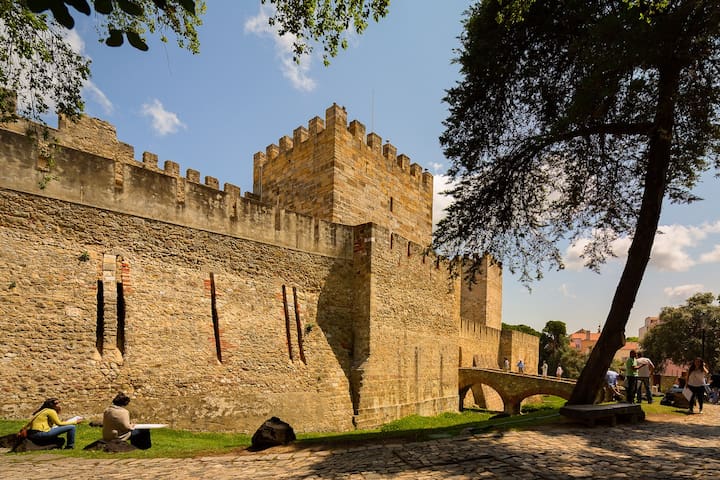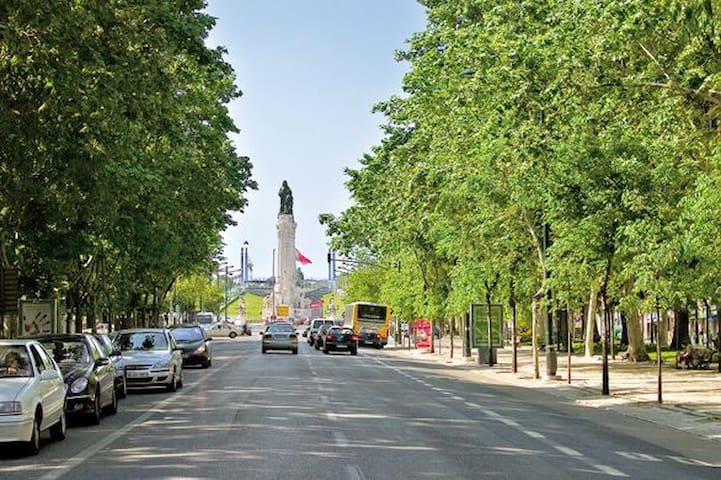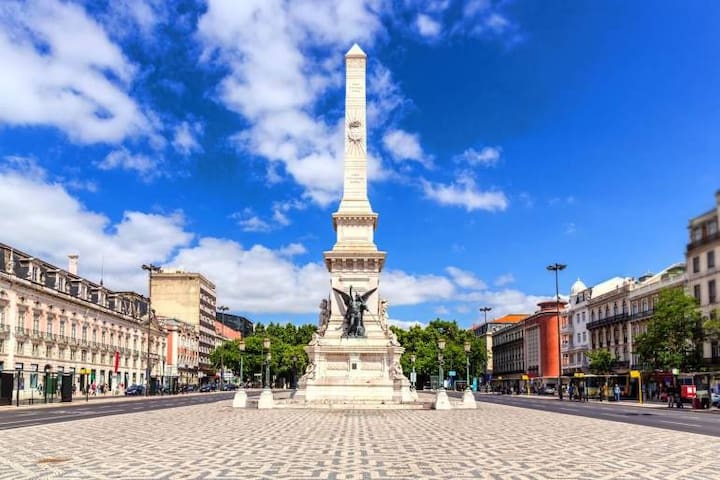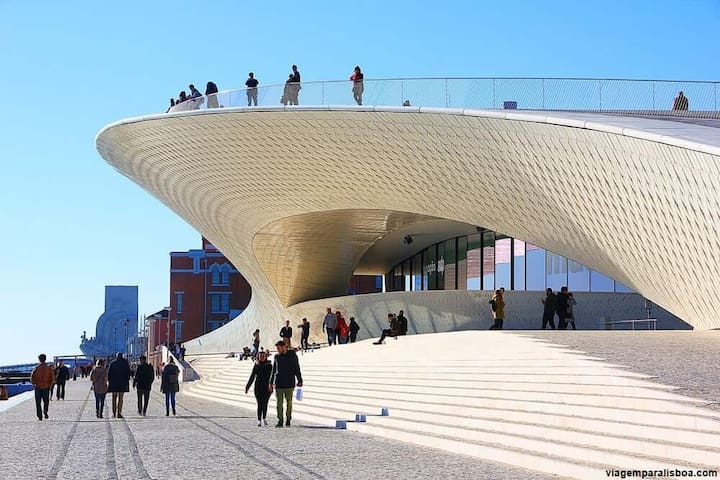Sightseeing
Must See for all Lisbon Travelers
The Castelo de Sao Jorge stands majestically above Lisbon and is one of the finest tourist attractions in the city.
The castle is entwined in Lisbon’s early history; it saw the fall of the Romans to the Visigoths, experienced the fierce conflicts between the Arabs and Christians, survived formidable sieges by the Castilians and witnessed the birth of Portugal as a seafaring nation.
This varied and turbulent history is reflected throughout the castle. There are heavily fortified battlements, medieval royal quarters and seaward views, which inspired exploration within Portuguese kings.
1774 icetyiswa ngabantu basekuhlaleni
I-Castle ye-S. Jorge
Rua de Santa Cruz do CasteloThe Castelo de Sao Jorge stands majestically above Lisbon and is one of the finest tourist attractions in the city.
The castle is entwined in Lisbon’s early history; it saw the fall of the Romans to the Visigoths, experienced the fierce conflicts between the Arabs and Christians, survived formidable sieges by the Castilians and witnessed the birth of Portugal as a seafaring nation.
This varied and turbulent history is reflected throughout the castle. There are heavily fortified battlements, medieval royal quarters and seaward views, which inspired exploration within Portuguese kings.
Avenida da Liberdade has a history as one of Lisbon’s most eye-catching neighbourhoods, built as a park in the 18th century and converted in the late 19th century into the high-end boulevard that it is today. Designed in the image of Paris’s Champs-Elysees, it’s filled with grand buildings that house luxury shopping, five-star hotels, a range of restaurants and floral pedestrian walkways decorated with kiosk cafés and the traditional Portuguese tile.
620 icetyiswa ngabantu basekuhlaleni
Avenida da Liberdade
Avenida da LiberdadeAvenida da Liberdade has a history as one of Lisbon’s most eye-catching neighbourhoods, built as a park in the 18th century and converted in the late 19th century into the high-end boulevard that it is today. Designed in the image of Paris’s Champs-Elysees, it’s filled with grand buildings that house luxury shopping, five-star hotels, a range of restaurants and floral pedestrian walkways decorated with kiosk cafés and the traditional Portuguese tile.
The Praça dos Restauradores is central Lisbon’s most interesting plaza, which combines classical 17th century architecture with ornate art deco buildings. The square is often disregarded by many Portuguese but the Praça dos Restauradores offers tourists a section of varied and historically important sights and attractions.
At the centre of the square is the imposing Restauradores obelisk, which commemorates the independence of Portugal from Spain. Overlooking the obelisk is the sumptuous Palacio Foz with its distinctive pink exterior and grand interior. Next to the place is the stunning art deco Eden Theatre that has been converted into an exclusive hotel.
The fourth tourist attraction is the quaint Elevador da Gloria, a set of two carriages that climb the steep hill into the Bairro Alto district. The Praça dos Restauradores is varied, interesting and is rightly one of Lisbon’s finest plazas.
Restauradores Square
Praça dos RestauradoresThe Praça dos Restauradores is central Lisbon’s most interesting plaza, which combines classical 17th century architecture with ornate art deco buildings. The square is often disregarded by many Portuguese but the Praça dos Restauradores offers tourists a section of varied and historically important sights and attractions.
At the centre of the square is the imposing Restauradores obelisk, which commemorates the independence of Portugal from Spain. Overlooking the obelisk is the sumptuous Palacio Foz with its distinctive pink exterior and grand interior. Next to the place is the stunning art deco Eden Theatre that has been converted into an exclusive hotel.
The fourth tourist attraction is the quaint Elevador da Gloria, a set of two carriages that climb the steep hill into the Bairro Alto district. The Praça dos Restauradores is varied, interesting and is rightly one of Lisbon’s finest plazas.
Praça do Comércio (Commerce Square) is a large, historic square on the banks of the River Tagus in Lisbon. It was built on the site previously occupied by the Terreiro do Paço (Palace Yard) following its destruction in the 1755 earthquake. Lisboetas often still use the previous name for the square.
Along with the Arco da Rua Augusta at its northern end, the Praça do Comércio is one of the centerpieces of the redevelopment of the Baixa district of the Portuguese capital by the Marquis of Pombal in the mid-18th century.
717 icetyiswa ngabantu basekuhlaleni
Iphondo lomthengisi
Praça do ComércioPraça do Comércio (Commerce Square) is a large, historic square on the banks of the River Tagus in Lisbon. It was built on the site previously occupied by the Terreiro do Paço (Palace Yard) following its destruction in the 1755 earthquake. Lisboetas often still use the previous name for the square.
Along with the Arco da Rua Augusta at its northern end, the Praça do Comércio is one of the centerpieces of the redevelopment of the Baixa district of the Portuguese capital by the Marquis of Pombal in the mid-18th century.
Jutting out of the water off the Belem riverfront, the quirky-looking Belém Tower is one of the most recognized of all Lisbon's tourist attractions and has become a symbol of the city. Completed in 1521, it originally functioned as a fortress to defend the mouth of the River Tagus and would have sat in the middle of the estuary (time and tide has shifted the river's course). The tower was built during the reign of King Manuel I and as such is regaled with plenty of Manueline architectural symbolism - carved stone maritime motifs like coiled and twisted rope, armillary spheres, and the Cross of the Order of Christ, a military order that helped finance early voyages of discovery.
216 icetyiswa ngabantu basekuhlaleni
Belém
Jutting out of the water off the Belem riverfront, the quirky-looking Belém Tower is one of the most recognized of all Lisbon's tourist attractions and has become a symbol of the city. Completed in 1521, it originally functioned as a fortress to defend the mouth of the River Tagus and would have sat in the middle of the estuary (time and tide has shifted the river's course). The tower was built during the reign of King Manuel I and as such is regaled with plenty of Manueline architectural symbolism - carved stone maritime motifs like coiled and twisted rope, armillary spheres, and the Cross of the Order of Christ, a military order that helped finance early voyages of discovery.
This iconic piece of modern architecture on the waterfront was designed by British architect Amanda Levete and opened in the fall of 2016. It stands next to a former power plant which was previously the Electricy Museum, and that is now also part of the Museum of Art, Architecture and Technology. Both buildings present temporary exhibitions of major international and local artists, directed by the former curator of contemporary architecture of New York’s MoMA.
It's possible to walk over the building, which serves as a beautiful lookout terrace, while a series of steps by the entrance descend toward the river.
529 icetyiswa ngabantu basekuhlaleni
MAAT
Avenida BrasíliaThis iconic piece of modern architecture on the waterfront was designed by British architect Amanda Levete and opened in the fall of 2016. It stands next to a former power plant which was previously the Electricy Museum, and that is now also part of the Museum of Art, Architecture and Technology. Both buildings present temporary exhibitions of major international and local artists, directed by the former curator of contemporary architecture of New York’s MoMA.
It's possible to walk over the building, which serves as a beautiful lookout terrace, while a series of steps by the entrance descend toward the river.
The Jerónimos Monastery, a UNESCO World Heritage Site, is a must-see for any visitor to Lisbon. Here are some reasons why:
Architectural Marvel: The monastery is a stunning example of Manueline architecture, a distinctive Portuguese style characterized by intricate carvings, ornate details, and nautical motifs.
Historical Significance: It was built to commemorate the return of Vasco da Gama from his voyage to India, marking a pivotal moment in Portuguese history.
Tomb of Vasco da Gama: The monastery houses the tomb of Vasco da Gama, one of Portugal's most famous explorers.
Tranquil Cloisters: The monastery's cloisters offer a peaceful oasis away from the bustling city, providing a serene setting for reflection.
Nearby Attractions: The Jerónimos Monastery is located in the Belém district, which is also home to other popular attractions such as the Belém Tower and the Pastéis de Belém bakery, famous for its delicious custard tarts.
If you're interested in history, architecture, or simply want to experience the beauty of Lisbon, a visit to the Jerónimos Monastery is highly recommended.
893 icetyiswa ngabantu basekuhlaleni
IJerónimos Monastery
The Jerónimos Monastery, a UNESCO World Heritage Site, is a must-see for any visitor to Lisbon. Here are some reasons why:
Architectural Marvel: The monastery is a stunning example of Manueline architecture, a distinctive Portuguese style characterized by intricate carvings, ornate details, and nautical motifs.
Historical Significance: It was built to commemorate the return of Vasco da Gama from his voyage to India, marking a pivotal moment in Portuguese history.
Tomb of Vasco da Gama: The monastery houses the tomb of Vasco da Gama, one of Portugal's most famous explorers.
Tranquil Cloisters: The monastery's cloisters offer a peaceful oasis away from the bustling city, providing a serene setting for reflection.
Nearby Attractions: The Jerónimos Monastery is located in the Belém district, which is also home to other popular attractions such as the Belém Tower and the Pastéis de Belém bakery, famous for its delicious custard tarts.
If you're interested in history, architecture, or simply want to experience the beauty of Lisbon, a visit to the Jerónimos Monastery is highly recommended.
The Boca do Inferno (Mouth of Hell) is a dramatic sea cave located on the coast of Portugal, near the town of Sintra. It's a popular tourist destination known for its stunning natural beauty and legend.
Here's what you can expect when visiting the Boca do Inferno:
Dramatic Cliffs: The cave is situated within towering cliffs, creating a breathtaking backdrop.
Powerful Waves: The sea often crashes against the cliffs, creating a powerful and impressive spectacle.
Legend of the Devil: The cave's name comes from a legend that it was the entrance to Hell, created by the Devil himself.
Breathtaking Views: Enjoy panoramic views of the Atlantic Ocean and the surrounding coastline.
212 icetyiswa ngabantu basekuhlaleni
Boca do Inferno
The Boca do Inferno (Mouth of Hell) is a dramatic sea cave located on the coast of Portugal, near the town of Sintra. It's a popular tourist destination known for its stunning natural beauty and legend.
Here's what you can expect when visiting the Boca do Inferno:
Dramatic Cliffs: The cave is situated within towering cliffs, creating a breathtaking backdrop.
Powerful Waves: The sea often crashes against the cliffs, creating a powerful and impressive spectacle.
Legend of the Devil: The cave's name comes from a legend that it was the entrance to Hell, created by the Devil himself.
Breathtaking Views: Enjoy panoramic views of the Atlantic Ocean and the surrounding coastline.
The Palácio Nacional de Sintra is a stunning palace located in the town of Sintra, Portugal. It's a UNESCO World Heritage Site and one of the most popular tourist attractions in the country.
Here are some of the highlights of the palace:
Architectural Beauty: The palace showcases a unique blend of architectural styles, including Moorish, Gothic, and Manueline.
Ornate Interiors: The palace's interiors are adorned with intricate carvings, tiles, and frescoes.
Royal Rooms: Explore the former royal chambers, including the King's Room and the Queen's Room.
Courtyards: Stroll through the beautiful courtyards and gardens surrounding the palace.
Views of Sintra: Enjoy panoramic views of the town and surrounding countryside from the palace's terraces.
435 icetyiswa ngabantu basekuhlaleni
Sintra National Palace
Largo Rainha Dona AméliaThe Palácio Nacional de Sintra is a stunning palace located in the town of Sintra, Portugal. It's a UNESCO World Heritage Site and one of the most popular tourist attractions in the country.
Here are some of the highlights of the palace:
Architectural Beauty: The palace showcases a unique blend of architectural styles, including Moorish, Gothic, and Manueline.
Ornate Interiors: The palace's interiors are adorned with intricate carvings, tiles, and frescoes.
Royal Rooms: Explore the former royal chambers, including the King's Room and the Queen's Room.
Courtyards: Stroll through the beautiful courtyards and gardens surrounding the palace.
Views of Sintra: Enjoy panoramic views of the town and surrounding countryside from the palace's terraces.
Best Beaches for theThe Beautiful Beaches of Costa da Caparica
Costa da Caparica, located on the south bank of the Tagus River, is a paradise for beach lovers, offering miles of golden sand, perfect waves for surfers, and a relaxing atmosphere.
Why visit Costa da Caparica?
Variety of beaches: From calm beaches ideal for families to beaches with high waves for surfers, there's a beach for everyone.
Easy access: Costa da Caparica is located just a few kilometers from Lisbon, making it an easy destination to reach.
Activities: In addition to sunbathing and swimming, you can surf, paddleboard, play beach volleyball, and much more.
Nightlife: At night, Costa da Caparica offers a variety of bars and restaurants, perfect for relaxing after a day at the beach.
Some of the most popular beaches on Costa da Caparica:
Praia da Rainha: Known for its calm waters and ideal for families with children.
Praia do Sol: One of the most extensive beaches on Costa da Caparica, popular among surfers and kitesurfers.
Praia de São João: A wilder beach with dunes and natural vegetation.
Praia de Fonte da Telha: A quieter beach, ideal for those seeking relaxation.
What to do on Costa da Caparica besides going to the beach?
Hiking or biking: Explore the coast on trails that offer panoramic views.
Visit the Forte de São João da Caparica: A historic fortress with views of the ocean.
Try the local cuisine: Enjoy fresh seafood and traditional Portuguese dishes.
Tips for enjoying Costa da Caparica to the fullest:
Plan your visit: Check the weather forecast before going and choose the ideal beach for your activities.
Bring sunscreen, hat, and water: Protect yourself from the sun.
Respect the environment: Keep the beach clean and avoid leaving litter.
Costa da Caparica is a perfect destination for those seeking sun, sea, and adventure. Come discover its beautiful beaches and enjoy everything it has to offer! locals, is
Praias
Best Beaches for theThe Beautiful Beaches of Costa da Caparica
Costa da Caparica, located on the south bank of the Tagus River, is a paradise for beach lovers, offering miles of golden sand, perfect waves for surfers, and a relaxing atmosphere.
Why visit Costa da Caparica?
Variety of beaches: From calm beaches ideal for families to beaches with high waves for surfers, there's a beach for everyone.
Easy access: Costa da Caparica is located just a few kilometers from Lisbon, making it an easy destination to reach.
Activities: In addition to sunbathing and swimming, you can surf, paddleboard, play beach volleyball, and much more.
Nightlife: At night, Costa da Caparica offers a variety of bars and restaurants, perfect for relaxing after a day at the beach.
Some of the most popular beaches on Costa da Caparica:
Praia da Rainha: Known for its calm waters and ideal for families with children.
Praia do Sol: One of the most extensive beaches on Costa da Caparica, popular among surfers and kitesurfers.
Praia de São João: A wilder beach with dunes and natural vegetation.
Praia de Fonte da Telha: A quieter beach, ideal for those seeking relaxation.
What to do on Costa da Caparica besides going to the beach?
Hiking or biking: Explore the coast on trails that offer panoramic views.
Visit the Forte de São João da Caparica: A historic fortress with views of the ocean.
Try the local cuisine: Enjoy fresh seafood and traditional Portuguese dishes.
Tips for enjoying Costa da Caparica to the fullest:
Plan your visit: Check the weather forecast before going and choose the ideal beach for your activities.
Bring sunscreen, hat, and water: Protect yourself from the sun.
Respect the environment: Keep the beach clean and avoid leaving litter.
Costa da Caparica is a perfect destination for those seeking sun, sea, and adventure. Come discover its beautiful beaches and enjoy everything it has to offer! locals, is
Explore this historic neighborhood with its narrow streets, charming squares, and fado houses.
Alfama
Explore this historic neighborhood with its narrow streets, charming squares, and fado houses.
The largest square in Lisbon, offering beautiful views of the Tagus River.
717 icetyiswa ngabantu basekuhlaleni
Iphondo lomthengisi
Praça do ComércioThe largest square in Lisbon, offering beautiful views of the Tagus River.
The Calouste Gulbenkian Museum is a must-see for art lovers visiting Lisbon. Here's why:
1. Impressive Collection: The museum houses one of the world's most important private art collections, spanning over 5,000 years of history. You'll find masterpieces from Ancient Egypt, Islamic art, Western painting, and more.
2. Diverse Highlights: Some of the museum's highlights include:
Sculpture: A stunning collection of sculptures from ancient Greece to the 20th century.
Painting: Masterpieces by renowned artists like Rembrandt, Renoir, and Monet.
Islamic Art: A rich collection of Islamic artifacts, including ceramics, textiles, and metalwork.
Ancient Art: Explore the treasures of ancient civilizations, from Egyptian artifacts to Greco-Roman sculptures.
3. Beautiful Architecture: The museum itself is a work of art, designed by renowned architects to showcase the collection in a stunning setting.
4. Temporary Exhibitions: In addition to the permanent collection, the museum regularly hosts temporary exhibitions featuring works from around the world.
5. Peaceful Surroundings: The museum is located in a peaceful garden setting, providing a relaxing atmosphere for visitors.
Here's a quick overview of the museum's opening hours and admission:
Opening hours: 10:00 AM to 6:00 PM, closed on Tuesdays and certain holidays.
Admission: Tickets can be purchased online or at the museum.
Don't miss the opportunity to explore this cultural gem during your stay in Lisbon!
779 icetyiswa ngabantu basekuhlaleni
I-Museum Calouste Gulbenkian
45A Av. de BernaThe Calouste Gulbenkian Museum is a must-see for art lovers visiting Lisbon. Here's why:
1. Impressive Collection: The museum houses one of the world's most important private art collections, spanning over 5,000 years of history. You'll find masterpieces from Ancient Egypt, Islamic art, Western painting, and more.
2. Diverse Highlights: Some of the museum's highlights include:
Sculpture: A stunning collection of sculptures from ancient Greece to the 20th century.
Painting: Masterpieces by renowned artists like Rembrandt, Renoir, and Monet.
Islamic Art: A rich collection of Islamic artifacts, including ceramics, textiles, and metalwork.
Ancient Art: Explore the treasures of ancient civilizations, from Egyptian artifacts to Greco-Roman sculptures.
3. Beautiful Architecture: The museum itself is a work of art, designed by renowned architects to showcase the collection in a stunning setting.
4. Temporary Exhibitions: In addition to the permanent collection, the museum regularly hosts temporary exhibitions featuring works from around the world.
5. Peaceful Surroundings: The museum is located in a peaceful garden setting, providing a relaxing atmosphere for visitors.
Here's a quick overview of the museum's opening hours and admission:
Opening hours: 10:00 AM to 6:00 PM, closed on Tuesdays and certain holidays.
Admission: Tickets can be purchased online or at the museum.
Don't miss the opportunity to explore this cultural gem during your stay in Lisbon!
Chiado
Stroll through this elegant neighborhood with its bookstores, cafes, and theaters.
oceanarium
Not only is this one of the largest aquariums in the world, it's also one of the best designed. Although the over 25,000 sea creatures seem to be swimming together, sharks are separated from smaller defenseless fish by invisible acrylic walls. It's the first aquarium to place all world ocean habitats together, and presents several marine species, from the curious round stingrays to the giant sunfish, seahorses, otters and penguins... In 2017 it inaugurated a new sardine tank.
The main building, rising from the Tagus, was built for the 1998 World Fair, while an annex was inaugurated in 2011 to house sea turtles.
The main attraction is the gigantic tank visible from four different levels, where high-tech displays explain everything in different languages.
571 icetyiswa ngabantu basekuhlaleni
Lisbon Oceanarium
s/nº Esplanada Dom Carlos INot only is this one of the largest aquariums in the world, it's also one of the best designed. Although the over 25,000 sea creatures seem to be swimming together, sharks are separated from smaller defenseless fish by invisible acrylic walls. It's the first aquarium to place all world ocean habitats together, and presents several marine species, from the curious round stingrays to the giant sunfish, seahorses, otters and penguins... In 2017 it inaugurated a new sardine tank.
The main building, rising from the Tagus, was built for the 1998 World Fair, while an annex was inaugurated in 2011 to house sea turtles.
The main attraction is the gigantic tank visible from four different levels, where high-tech displays explain everything in different languages.




